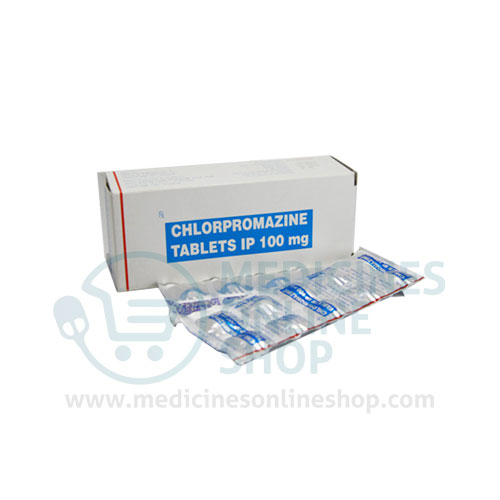What is this drug used for?
• It is used to treat hiccups.
• It is used to treat tetanus.
• It is used to treat problems with how one acts.
• It is used to treat acute intermittent porphyria.
• It is used to treat mania.
• It is used to treat upset stomach and throwing up.
• It is used to treat schizophrenia.
• It is used to ease anxiety before surgery.
• It may be given to you for other reasons. Talk with the doctor.
Frequently reported side effects of this drug
• Constipation
• Dry mouth
• Fatigue
• Stuffy nose
• Nausea
Other side effects of this drug: Talk with your doctor right away if you have any of these signs of:
• Infection
• Neuroleptic malignant syndrome like fever, muscle cramps or stiffness, dizziness, severe headache, confusion, change in thinking, fast heartbeat, abnormal heartbeat, or sweating a lot.
• High blood sugar like confusion, fatigue, increased thirst, increased hunger, passing a lot of urine, flushing, fast breathing, or breath that smells like fruit.
• Low blood sugar like dizziness, headache, fatigue, feeling weak, shaking, fast heartbeat, confusion, increased hunger, or sweating.
• Tardive dyskinesia like unable to control body movements; tongue, face, mouth, or jaw sticking out; mouth puckering; or puffing cheeks.
• Fast heartbeat
• Yellow skin
• Abnormal heartbeat
• Erection that lasts more than 4 hours
• Abnormal movements
• Twitching
• Change in balance
• Agitation
• Muscle weakness
• Difficulty swallowing
• Difficulty speaking
• Dizziness
• Passing out
• Tremors
• Difficulty moving
• Rigidity
• Drooling
• Behavioral changes
• Seizures
• Swelling of arms or legs
• Vision changes
• Bruising
• Bleeding
• Enlarged breasts
• Nipple discharge
• Sexual dysfunction
• No menstrual periods
• Difficult urination
• Unable to pass urine
• Severe loss of strength and energy
• Trouble sleeping
• Signs of a significant reaction like wheezing; chest tightness; fever; itching; bad cough; blue skin color; seizures; or swelling of face, lips, tongue, or throat.
Note: This is not a comprehensive list of all side effects. Talk to your doctor if you have questions.
Pronunciation
(klor PROE ma zeen)
Medication Safety Issues
Sound-alike/look-alike issues:
ChlorproMAZINE may be confused with chlordiazePOXIDE, chlorproPAMIDE, clomiPRAMINE, prochlorperazine, promethazine
Thorazine may be confused with thiamine, thioridazine
Storage and Stability
Oral: Store at 20°C to 25°C (68°F to 77°F); protect from light and moisture.
Injection solution: Store at 20°C to 25°C (68°F to 77°F); excursions permitted to 15°C to 30°C (59°F to 86°F). Protect from light and freezing. A slightly yellowed solution does not indicate potency loss, but a markedly discolored solution should be discarded.
Adverse Reactions
Cardiovascular: ECG abnormality (nonspecific QT changes), orthostatic hypotension, syncope, tachycardia
Central nervous system: Brain edema, catatonic-like state, dizziness, drowsiness, dystonia, extrapyramidal reaction, hyperpyrexia, neuroleptic malignant syndrome, parkinsonism, psychotic symptoms, restlessness, tardive dyskinesia, tardive dystonia
Dermatologic: Contact dermatitis, cutaneous lupus erythematosus (Pavlidakey 1985), skin photosensitivity, skin pigmentation (slate gray)
Endocrine & metabolic: Weight gain
Gastrointestinal: Atony of colon, constipation, increased appetite, nausea, obstipation, paralytic ileus, xerostomia
Genitourinary: Breast engorgement, ejaculatory disorder, false positive pregnancy test, impotence, lactation, priapism, urinary retention
Hematologic & oncologic: Agranulocytosis, aplastic anemia, eosinophilia, hemolytic anemia, immune thrombocytopenia, leukopenia
Hepatic: Jaundice
Hypersensitivity: Nonimmune anaphylaxis
Neuromuscular & skeletal: Lupus-like syndrome (Pavlidakey 1985)
Ophthalmic: Corneal deposits, lens disease (deposits), miosis, mydriasis, star-shaped cataract, visual impairment
Respiratory: Nasal congestion
Miscellaneous: Low fever
Postmarketing: Abnormal proteins in cerebrospinal fluid, amenorrhea, angioedema, asthma, epithelial keratopathy, exfoliative dermatitis, glycosuria, gynecomastia, hyperglycemia, hypoglycemia, laryngeal edema, pancytopenia, peripheral edema, retinitis pigmentosa, seizure




